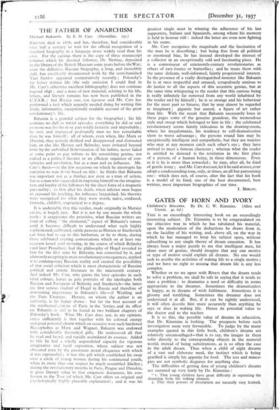GATES OF HORN AND IVORY
THIS is an exceedingly interesting book on an exceedingly interesting subject. Dr. Kimmins is to be congratulated on the objective way in which he has tabulated his material, upon the moderation of the deductions he draws from it, on the lucidity of his writing, and, above all, on the way in which he has managed to keep his subject open, without subscribing to any single theory of dream causation. It has always been a major puzzle to me that intelligent men, let alone men of genius, should imagine that any one motive or type of motive could explain all dreams. No one would seek to ascribe the activities of waking life to a single motive ; and we have no right to assume that dream life is any less complex.
Whether or no we agree with Rivers that the dream tends to solve a problem, we shall be safe in saying that it tends to state a problem : to dramatise a need or difficulty in terms appropriate to the dreamer. Sometimes the dramatisation is happy, as in dreams of wish fulfilment. Sometimes it is gloomy and terrifying. Sometimes the dreamer does not understand it at all. But, if it can be rightly understood, it will often describe him more accurately than anything he says or does in waking life. Hence its potential value to the doctor and to the teacher.
It is to this, the possible value of dreams in education, that Dr. Kimmins is looking. The prospects before such investigation seem very favourable. To judge by the many examples quoted in this little book, children's dreams are relatively uncamouflaged—that is to say, the images in them refer directly to the corresponding objects in the material world, instead of being substitutions, as is so often the case in the adult dream. Thus when a child of eight dreams of a vast and elaborate meal, the instinct which is being gratified is simply his appetite for food. The ices and mince- pies are not symbolic disguises for anything else.
The difficulties of getting data of young children's dreams are summed up very fairly by Dr. Kimmins :
" 1. That young children have great difficulty in separating the dreaming from the waking element.
2. That their powers of description are naturally very limited,
and that their use of words may convey to the adult mind a very different impression from that which they wish to convey. 3. That the child will inevitably fill up gaps in the dream, and will reject as absurd some items in the dream which are contrary to his own experience.
4. A dream described even a few hours after awaking is a very different record from that obtained directly the child awakes, in consequence of the fusion of the dream material with waking thoughts."
On the other side is the undoubted fact that children show a precocious literary ability in their dreams.
" This power so far exceeds their ability in ordinary essay-writing on topics suggested by the teacher, and is, moreover, so much in advance of their general standard of achievement, that it would appear as if some fresh mental element had come into play."
The book is full of interesting observations. Children under nine rarely experience kinaesthetic dreams, which—
a highly suggestive discovery—are practically non-existent among the deaf. Boys have more fear dreams than girls. Their usual terrors concern robbers, burglars, and the larger animals. Girls fear old men, dogs, rats, mice, and snakes.
Deaf children are much more afraid of animals than are blind.
The dreams of children in industrial schools are far more interesting and rich in content than those in normal schools. Secondary school children differ interestingly from elementary school children. Their dreams are influenced in greater degree by school activities, and by the cinema, and their wish fulfilment dreams are different in content. (The general influence of the cinema, by the way, appears to be small.) One kind of dream Dr. Kimmins does not mention, though a sentence on " racial inheritance " suggests that he is aware of it. I mean the dream in which a child, too young to have read or heard of it, sees or takes part in a Greek or Roman myth, usually of a sexual nature. I have come across several instances of such dreams, related quite frankly by the child, who has obviously not the least appreciation of the significance of his dream.
There is in this unassuming survey only one phrase which seems open to question. To call the dreams in which wounded soldiers regained their lost limbs " compensatory " is, surely, to make a larger assumption than is justified. Dr. Kimmins deserves the gratitude of all who are interested in children for a book which, supplementing the work of Piaget, Green, Mary Chadwick, and others, may encourage and stabilise a most promising field for research. L. A. G. STRONG.

































 Previous page
Previous page